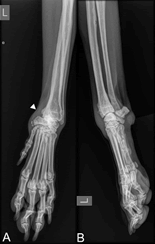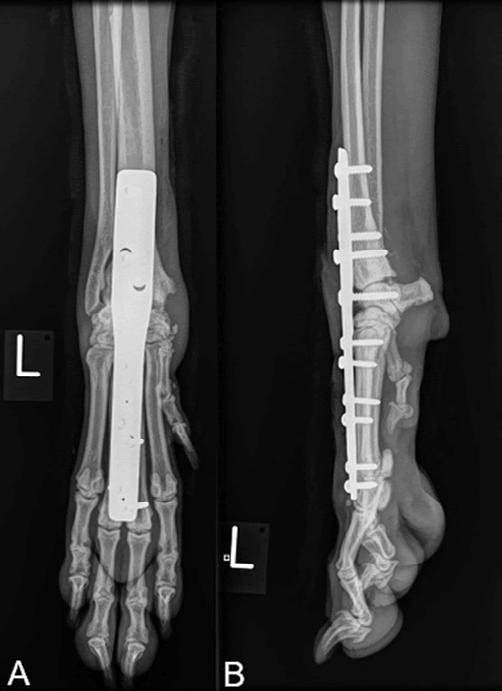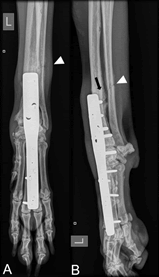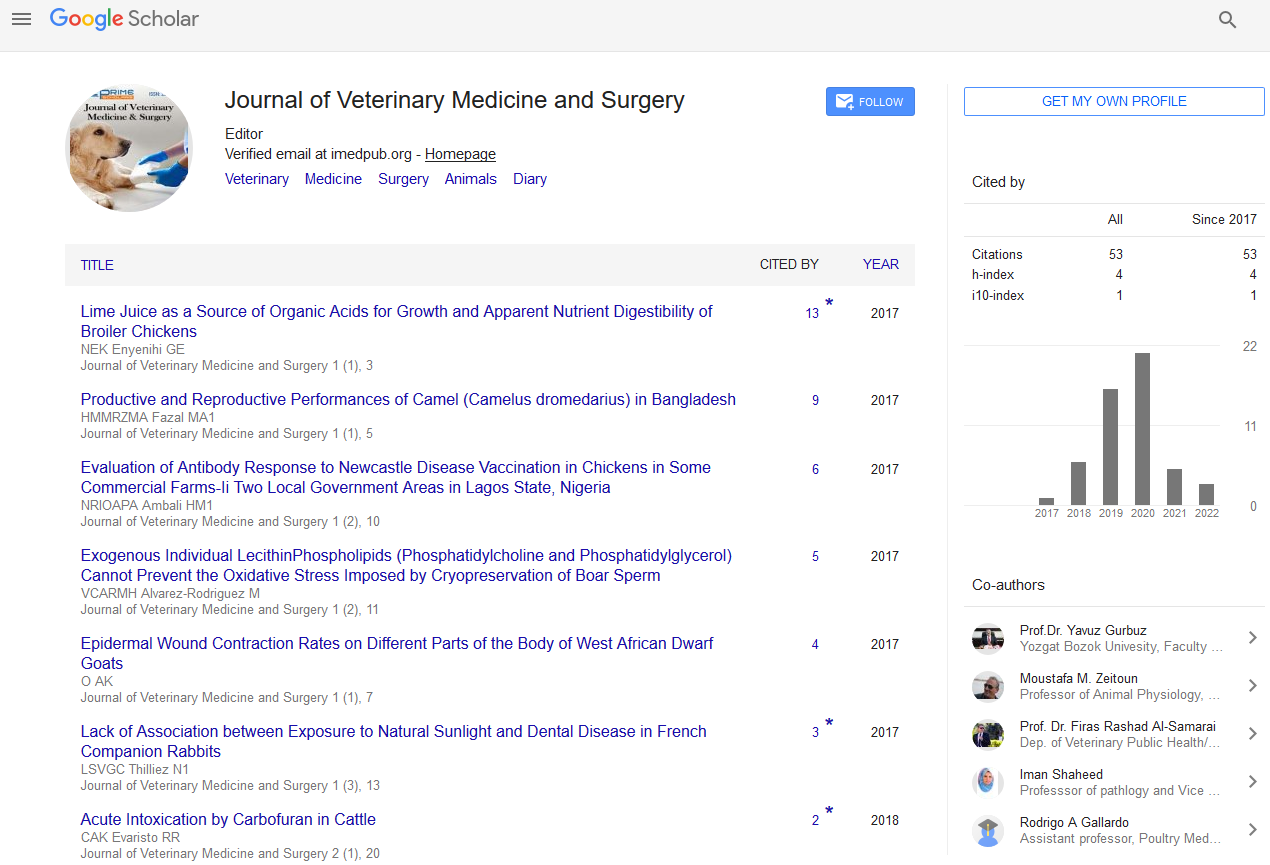Case Report - (2024) Volume 8, Issue 3
Case Report: Conservative treatment for ulnar fracture after pancarpal arthrodesis
Stefan Keider1* and
Petar Polajnar2
1Anicura Tierklinik Erdberg, Vienna, Austria
2VetTrust Tierklinik Basel, Basel, Switzerland
*Correspondence:
Stefan Keider,
Anicura Tierklinik Erdberg, Vienna,
Austria,
Email:
Received: 02-Jul-2024, Manuscript No. IPJVMS-24-20685;
Editor assigned: 04-Jul-2024, Pre QC No. IPJVMS-24-20685 (PQ);
Reviewed: 08-Jul-2024, QC No. IPJVMS-24-20685;
Revised: 12-Jul-2024, Manuscript No. IPJVMS-24-20685 (R);
Published:
15-Jul-2024
Abstract
An 8-year-old neutered mixed-breed female dog weighing 28 kg was presented with mild front limb lameness 4 weeks after pancarpal arthrodesis. Orthopedic examination revealed discomfort during the antebrachial manipula�tion. Radiographic examination revealed an ipsilateral diaphyseal ulnar fracture at the level of the proximal border of the pancarpal arthrodesis plate. Solid periosteal new bone formation in the area of the fracture and around the tip of the most proximal screw on the transcortex of the adjacent radius was detected. The oblique ulnar fracture was not displaced. Cage rest for 4 weeks was elected over surgical intervention. No lameness was detected on clinical examination 2 weeks later. The ulnar fracture showed delayed union evident on radiographs at 17 weeks postoperatively.
Since this is the first report of an ulnar fracture after pancarpal arthrodesis, there are no treatment recommenda�tions for this complication. Based on the clinical outcomes of this case, conservative treatment of ulnar fracture in a healthy, adult, large breed dog should be considered as an alternative for aggressive interventions.
Keywords
Pancarpal arthrodesis; Ulnar fracture; Osteomyelitis; Periosteal new bone formation; CastLess
Introduction
Pancarpal Arthrodesis (PCA) in dogs is usually performed as
a salvage procedure for hyperextension injuries, collateral
ligament injuries, non-repairable articular fractures, shearing
injuries, end-stage degenerative joint disease, immunemediated
polyarthritis of the carpus, or neurogenic injury
affecting the distal limb [1,2]. Palmar, medial, and dorsal
pancarpal arthrodesis techniques are described. The ideal
angle for pancarpal arthrodesis is 10-12 degrees of extension
of the antebrachiocarpal joint [3].
Complications after PCA include implant breakage, screw
loosening, fracture of the metacarpal bones, discomfort
associated with the implants, incomplete arthrodesis, infection,
osteomyelitis, and continual gait abnormality [3-5].
During plate application, stress risers are created in areas
where there is a transition from an area with a relatively high
moment of inertia to an area with a lower moment of inertia
[1,6].
Fractures in the vicinity of a bone plate are a well-known
complication in veterinary orthopedics [5,7-10]. Fractures of
adjacent bones after bone plating have been reported, for
example, in the fibula after tibia plateau leveling osteotomy
and in the metacarpus IV after PCA [5]. To the best of our
knowledge, there have been no reports of ulnar fractures after
PCA.
Case Presentation
The decision to perform PCA was made owing to an
antebrachiocarpal luxation resulting from jumping from a
height (Figure 1). The patient had no orthopedic disease in the
past.
A dorsal approach to the distal radius, carpus, and metacarpus
was performed [11]. A high-speed burr (Elan 4 BBraun,
Aesculap, Tuttlingen, Germany) was used to remove the articular cartilage from the antebrachiocarpal, middle carpal,
and carpometacarpal joints. Moreover, an autogenous
cancellous bone graft was harvested from the ipsilateral
proximal humerus and placed at the level of each joint. A
3.5 mm/2.7 mm CastLess PCA plate (CLP; Orthomed, Ltd.,
Halifax, West Yorkshire, UK) with a length of 130 mm was
deemed appropriate on pre-operative radiographs for covering
a maximum amount of length of the metacarpus as it is
recommended by the manufacturer. The plate was applied to
the bone in a standard dorsal orientation and all screw holes
were filled as foreseen. Four screws were placed in the radius;
one in the intermedioradial carpal bone; and three were placed
in the metacarpal bones III and IV (Figure 2).

Figure 1: Preoperative radiographs showing an antebrachiocarpal luxation: (A) dorsopalmar and (B) lateral

Figure 2: Immediate postoperative radiographs showing the arthrodesis plate and screws in place, without evidence of an ulnar fracture: (A) dorsopalmar and (B) lateral
The surgical wound was closed in layers. No bandages or
splints were used postoperatively. Postoperative radiographs
were obtained in two planes. Additionally, the position of the
implant was considered good. The postoperative PCA angle
was 2°. The canine patient was discharged the following day
with a prescription for meloxicam (0.1 mg/kg p.o. SID) and
Gabapentin (10 mg/kg p.o. TID) to be administered for 1 week.
No antibiotics were prescribed postoperatively. Furthermore,
cage rest was prescribed until re-check in 4 weeks.
Four weeks postoperatively, the dog was presented again for a
planned re-check with mild front limb lameness (1/4°) on the
operated leg. Orthopedic examination revealed mild swelling
and pain during palpation of the distal antebrachium.
Radiographs of the affected front limb revealed a closed,
diaphyseal, short oblique, non-displaced fracture of the
ipsilateral ulna at the level of the proximal end of the
arthrodesis plate. The owner reported no history of trauma.
Moderate solid periosteal new bone formation was noticed
circumferentially around the ulna in the area of the fracture
gap and at the caudal aspect of the distal ipsilateral radius at
the same level (Figure 3).

Figure 3: Radiographs four weeks postoperatively showing a closed, diaphyseal, short oblique, non-displaced fracture of the ipsilateral ulna at the level of the proximal end of the arthrodesis plate with moderate periosteal new bone formation at the ulna in the area of the fracture gap (arrowhead) and on the radius at the same level (black arrow): (A) dorsopalmar and (B) lateral
The body temperature was 39.1°C and the C-reactive protein
was mildly increased (18 mg/l, reference range 0-10 mg/l).
The antibiogram from fine needle aspiration of the area of
the ulnar fracture gap was negative. Amoxicillin-clavulanate
(22 mg/kg p.o. BID) was prescribed for four weeks. Cage rest
was recommended for 6 weeks. The patient showed no signs
of lameness, swelling, or pain in the affected front limb at a recheck
2 weeks later. Body temperature and C-reactive protein
were within normal limits again.
Radiographs taken 8 weeks postoperatively showed no
progression of healing of the ulnar fracture. Orthopedic
examination was again unremarkable; therefore, the cage rest
was set aside, and stepwise increasing exercise was allowed.
Radiography at 17 weeks showed a partially widened gap of
the ulnar fracture, compatible with delayed union (Figure 4).
The owner reported no lameness and was satisfied with the
outcome.
No further follow-up was possible, because the patient died
24 weeks postoperatively for a reason unrelated to the case
report.

Figure 4: Dorsopalmar radiograph four-month postoperatively, showing a partially widened fracture gap of the ulnar fracture (arrowhead)
Discussion
To the best of our knowledge, this is the first report describing
the postoperative complications of an ulnar fracture in a dog
following PCA. Isolated ulnar fractures, particularly in the distal
region, are rare. Stabilization of the ulna is usually unnecessary
if the radius is intact [12].
The location of the ulnar fracture at the level of the proximal
end of the plate on the radius suggests potential connection
to the PCA. Stress riser fractures at the ends of plates occur
as a result of the concentration of biomechanical forces at
the proximal and distal bone-implant interfaces because of
differences in elasticity between the plate and bone [7,8].
Stress riser fractures in the PCA have been described for
metacarpal bones III and IV, especially when not more than
50% of the length of the metacarpus is covered with the plate
[5]. Metacarpal fractures following the use of a CLP in PCA have
been reported in 3.8% of cases [13].
Fractures of adjacent bones after PCA were described for the
metacarpus IV [5]. Whitelock, et al. described two PCA cases
using a 2.7 mm or 3.5 mm dynamic compression plate with a
concomitant fracture of metacarpus IV. In both cases, the plate
was applied to metacarpus III, and no screws were placed in
metacarpus IV; nevertheless, fractures of MC III and MC IV at
the distal end of the plate have been identified postoperatively.
3.5 mm/2.7 mm CastLess PCA plates are available in 4 different
lengths (110 mm-140 mm). The difference in plate length only
concerns the distal part of the plate, which is applied to the
metacarpi. The proximal part of the plate, which is applied
to the radius and the radial carpal bone are identical in all
plate lengths. The four holes for placement of screws in the
radius and the hole for placement in the radial carpal bone
are therefore predefined. The manufacturer of the implant
suggests to cover a maximum length of the metacarpi III and
IV which was achieved in this case report using a plate of 130
mm length.
Postoperative PCA angle in this case was 2° in extension,
which was less than the suggested 10°-12° [2]. Additionally,
hyperextension of the carpus due to PCA might increase stress
risers at the distal end of the plate by increasing the moment
of weight-bearing forces at this point [5]. Whether the stress
riser also increases at the proximal end of the plate and in
the adjacent ulna remains unclear. To support this theory,
biomechanical studies are warranted.
In this case, no additional bandage or cast was applied at
any time. Several studies have reported no decrease in
complications when using postoperative bandages or casts
when performing PCA using a CLP [13,14].
The exact date of the event of ulnar fracture remains unclear,
since the owner did not report any incident. Furthermore, the
owner did not report a spontaneous change in the severity of
lameness and believed that the lameness was due to the PCA
procedure itself.
The radiographic pattern and extent of periosteal new bone
formation in the area of the fracture was suspicious for posttraumatic
osteomyelitis secondary to the ulnar fracture. A
mildly increased body temperature and mildly increased
C-reactive protein at 4 weeks postoperatively would support
this suspicion. Regarding the negative anti-biogram in this
case, negative culture results despite ongoing infection are
possible due to insufficient specimen volume or the presence
of fastidious bacteria [15]. Cytological examination could have
helped to identify possible bacterial infection.
In this case, inflammation potentially spared to the adjacent
radius. The radius potentially was susceptible to inflammation
because it had already weakened owing to recent screw
implantation. Early signs of infection in the form of periosteal
new bone formation have been reported for implant-associated
infections in the PCA [14]. Despite potential osteomyelitis, the
dog showed no lameness 6 weeks postoperatively.
Notably, the periosteal new bone formation diminished, as
documented on radiographs taken 4 months postoperatively.
The area of the fracture gap showed a decreased bone density,
and the ulna showed a partially mildly widened fracture gap.
The owner reported no lameness at that time.
Limitations of this study are a missing latero-lateral radiograph
at 17 weeks postoperatively and the impossibility for long
term follow-up. Biomechanical studies evaluating the ulna in
the context of PCA could potentially help to understand this
complication.
Conclusion
A postoperative PCA angle of 2° potentially leads to changed
biomechanics in the antebrachium and a stress riser at the
level of the proximal end of the PCA plate. This circumstance
potentially results in ulnar fractures. Considering the favorable
clinical outcome in this case, addressing the ulnar fracture
surgically seems unnecessary. Instead, strict cage rest and
regular monitoring are viable options.
Acknowledgement
None.
Conflict Of Interest
No conflicts of interest have been declared.
References
- Johnson AL, Houlton JEF (2005) AO principles of fracture management in the dog and cat. AO Publishing.
[Google Scholar]
- Lesser AS (2003) Arthrodesis. Saunders 2170-2180.
[Google Scholar]
- Kapatkin AS, Garcia-Nolen T, Hayashi K (2018) Carpus, metacarpus, and digits. Vet Surg Small Anim pp.932.
- Denny HR, Barr ARS (1991) Partial carpal and pancarpal arthrodesis in the dog: A review of 50 cases. J Small Anim Pract 32:329-334.
[Crossref] [Google Scholar]
- Whitelock RG, Dyce J, Houlton JE (1999) Metacarpal fractures associated with pancarpal arthrodesis in dogs. Vet Surg 28:25-30.
[Crossref] [Google Scholar]
- Vallefuoco R, Le Pommellet H, Savin A, Decambron A, Manassero M, et al. (2016) Complications of appendicular fracture repair in cats and small dogs using locking compression plates. Vet Comp Orthop Traumatol 29:46-52.
[Crossref] [Google Scholar]
- Liska WD (2004) Femur fractures associated with canine total hip replacement. Vet Surg 33:164-172.
[Crossref] [Google Scholar]
- Morgan MJ, Frazho JK (2018) Comparison of TPLO tibial tuberosity fractures with and without an in situ rotational pin. BMC Res Notes 11:368.
[Crossref] [Google Scholar]
- Li A, Gibson N, Carmichael S, Bennett D (1999) Thirteen pancarpal arthrodeses using 2.7/3.5 mm hybrid dynamic compression plates. Vet Comp Orthop Traumatol 12:102-107.
[Crossref] [Google Scholar]
- Tuttle TA, Manley PA (2009) Risk factors associated with fibular fracture after tibial plateau leveling osteotomy. Vet Surg 38:355-360.
[Crossref] [Google Scholar]
- Piermattei DL, Johnson KA (2004) Approach to the distal radius and carpus through a dorsal incision. 4th ed. Saunders pp.254-257.
- Fox DB (2018) Radius and ulna. Veterinary Surgery 2nd ed. pp.917-920.
- Bristow PC, Meeson RL, Thorne RM, Butterworth SJ, Rutherford S, et al. (2015) Clinical comparison of the hybrid dynamic compression plate and the castless plate for pancarpal arthrodesis in 219 dogs. Vet Surg 44:70-77.
[Crossref] [Google Scholar]
- Bokemeyer J, Fischer A, Sadan M, Kramer M, Gerwing M (2011) Pankarpale Arthrodese unter verwendung einer "castless plate" bei hunden und katzen [Pancarpal arthrodesis using a "CastLess Plate" in dogs and cats]. German Epub 39:7-16.
[Crossref] [Google Scholar]
- Sykes JE, Kapatkin AS (2014) Osteomyelitis, discospondylitis, and infectious arthritis. Elsevier 814-828.
[Crossref] [Google Scholar]
Citation: Keider S, Polajnar P (2024) Case Report: Conservative Treatment for Ulnar Fracture after Pancarpal Arthrodesis. J Veterinary Med. 8:21
Copyright: © 2024 Keider S, et al. This is an open-access article distributed under the terms of the Creative Commons Attribution License, which permits unrestricted use, distribution, and reproduction in any medium, provided the original author and source are credited.





